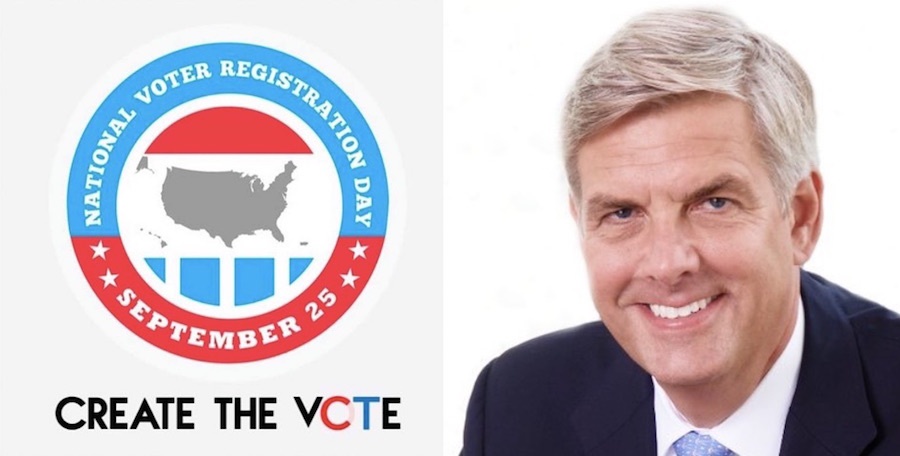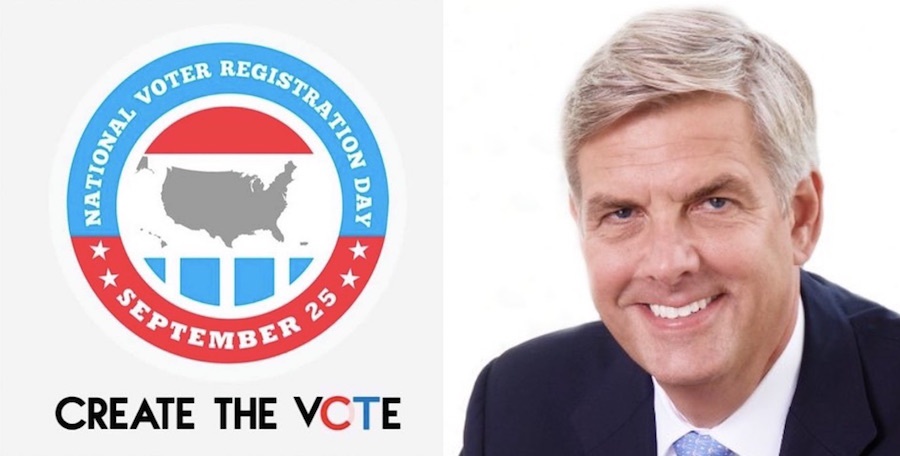

| Left: Create The Vote Photo. Right: Twitter. |
Increase appropriations for arts and culture. Bring in the private sector. Work more closely with the Connecticut Arts Alliance and do site-specific visits to nonprofits across the state.
Could Donald Trump-endorsed, tax-cutting, Ned-Lamont-bashing Republican gubernatorial candidate Bob Stefanowski be good for the arts?
Those are the questions raised—if briefly, and without specific answers—in Stefanowski’s new arts and culture questionnaire, released to Create The Vote CT on Sept. 27, and added to its website on Oct. 1 (read it here or below). Tuesday, the candidate is set to appear in Hartford with gubernatorial opponents Ned Lamont and Oz Griebel, in a candidate forum for the Connecticut Nonprofit Alliance.
Create The Vote CT is a joint initiative of the Connecticut Arts Alliance (CAA) and Connecticut Alliance for Arts Education (CAAE). Based on MassCreative’s 2017 initiative of the same name, it has now gained almost 100 co-sponsors from across the state.
Responding to a series of six questions that unaffiliated candidate Oz Griebel, Democratic hopeful Ned Lamont, Bridgeport mayor Joe Ganim (now out of the running) and fellow Republicans Tim Herbst and Mark Boughton (also out of the running) responded to before a debate in July, Stefanowski voiced a vague support for the arts without giving any particular examples or policy points. The move is in keeping with his campaign, which has declared a singular focus on tax cuts, put its money into television advertising, and remained otherwise shrouded in mystery. Throughout the campaign, he has given few interviews, largely mum on policy issues beyond taxes.
In the questionnaire, Stefanowski follows a rich history of not answering anything directly. He suggests that arts can resonate with a given moment and serve as a form of self expression, but doesn’t recall a moment where that happened in his own life (he hints at young adult years spent in New Haven, but doesn't say anything more). He proposes touring towns across Connecticut, to learn how arts are a selling point for new residents, and can bring in big jobs in the tech sector. He suggests that school funding for the arts should stay intact, but doesn’t give a sense of how that might happen amid floundering school budgets. And he suggests art is good for a talented workforce, without showing any examples.
The only suggestion that he does hint at, in fact, is the possibility of increasing appropriations for arts and culture as a way to boost the economy, and make Connecticut a more attractive place to live for businesses and tech hubs. But, he added, “I would really like to work with the business industry” to achieve that goal as well.
The complete survey is below, courtesy of Create The Vote CT. Responses are posted below exactly as provided by the candidate. To read about how previous candidates responded, check out our earlier coverage on the campaign trail here and gubernatorial forum on arts and the economy here.
1. Your Personal Connection to the Arts
We’ve all had defining moments in our lives. Is there a personal experience with arts, culture, or creativity that has had an impact on your life and your view of the community? And, if so, please tell us about it.
Connecticut has a rich history of valuing art and culture and growing up in New Haven we are fortunate to be able to access some of the best in the world being preserved and explored on a regular basis. As an adult I grew to understand how art and culture mirror what is happening in society at a given point in time through various view points. Art is self expression in a very personal way.
2. Arts + Economic Development
From April 1, 2018 Hartford Courant, Arts and Culture Are Key Contributors to CT’s Economy: “As an industry, arts and cultural events and productions pumped $9 billion into Connecticut’s economy in 2015, generating more money than utilities and construction, according to new figures from the U.S. Department of Commerce.” This same article noted that the arts and culture sector accounts for 3.5% of Connecticut’s total economy.
As governor, how would you recognize the importance of arts and culture in economic development and the revitalization of our cities?
As governor, I would like to visit towns and learn first hand how they successfully incorporated art and culture into their economic development plans and apply it statewide. The state needs to help market all the talent and diversity not only to increase tourism, but to make CT attractive for people to move into, and high tech jobs to invest in.
3. Arts Education + Programs for our Youth
Students with arts instruction are 3x more likely to be recognized for academic achievement, less likely to be absent, 5x more likely to graduate, and 44% less likely to use drugs.
Do you support arts education as a statewide priority? If so, how will you champion arts education for our youth?
The expression of art, and our cultural stores are fundamental development tools for our children. I believe that it is imperative that school funding to our municipalities and schools remain intact so art and cultural programs may remain in place.
4. Arts + Attracting/Retaining Talent
People want to live in culturally vibrant cities, and the arts and cultural scene influences in which city skilled workers want to work. They want to go to festivals, attend arts events, listen to live music, eat great food and meet interesting people. It’s a main reason why, according to a study by City Observatory, the number of college educated people age 25 to 34 living within three miles of city centers is up 37 percent since 2000, even as the total population of these neighborhoods has slightly shrunk.
How do you see the role of arts and culture in Connecticut’s effort to attract and retain a talented workforce?
I believe today’s workforce is more diversified and interested in the arts and culture and chose to live in communities and states that can offer them those choices. Therefore the more art and culture that is generated in our state, the better prepared we are to attract such talented workforce.
5. Arts + Return on Investment
The nonprofit arts and culture industry generates $80 million in revenue to local and state government. Yet the state recently allocated only $4.2 million for arts and culture in next year’s budget, which represents a 60% decrease since 2009.
Will you support increased state arts funding building on this return on investment? If so, at what level and from what funding source?
One of my priorities is to fund programs that will economically boost the state. Arts and Tourism plays a important role in creating such economic growth. Given that arts and culture generate $80 million in revenue on $4.2 million, I would consider increasing general appropriations for arts and culture but I would really like to work with the business industry and the Alliance to to bring private investment to help further promote your goal.
6. Arts + Tourism
Each year arts and cultural events attract 10 million attendees with 15% coming from outside the state and 59% of those tourists coming specifically for arts and culture.
Beyond featuring arts and culture in marketing efforts, how would you further capitalize on the arts as a cornerstone to CT’s vital tourism industry?
I believe our arts and culture should be part of every pitch made to businesses that are interested in investing and expanding to CT. Today’s workforce is diverse and they are looking to live in communities that offer those diverse experiences.

